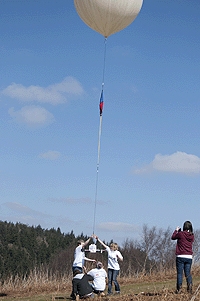The successful test launch - and recovery - is said to pave the way towards a longer-term plan to put a small satellite, built almost entirely by undergraduate students in the School of Engineering, into low-earth orbit at around 2,000km.
The eight students have been working for the past year on the Warwick University Satellite (WUSAT) Project, which has been building a 10cm wide CubeSat capable of carrying equipment including cameras and sensors.

The test launch took place at an approved site in Welshpool, where a high-altitude weather balloon lifted the satellite to an altitude of approximately 30km before it made a parachute descent to the ground.
For its test launch, the CubeSat carried three cameras, a radio communications link and a GPS tracker to aid recovery. It was designed to withstand temperatures down to -60C and transmit data and images up to a range of 30 miles.
In a statement Dr William Crofts, director of the Warwick Satellite Programme, said, ‘The WUSAT project is quite a unique set-up which aims to emulate real-world engineering teams.
‘Students from different engineering disciplines – such as manufacturing, electronics and mechanical engineering – all work together as they would in a real-life working environment.
‘It’s that experience, as well as the engineering knowledge the students are gaining, that is very valuable to employers.’
Industry sponsorship for the WUSAT project is provided by Roke Manor Research, Lyncolec, Solidworks, Thales, ITP Engines UK, National Instruments, Harwin and RS.




Red Bull makes hydrogen fuel cell play with AVL
Formula 1 is an anachronistic anomaly where its only cutting edge is in engine development. The rules prohibit any real innovation and there would be...